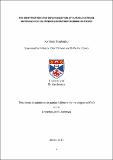Files in this item
The identification and down selection of suitable cathode materials for use in next generation thermal batteries
Item metadata
| dc.contributor.advisor | Irvine, John T. S. | |
| dc.contributor.advisor | Connor, Paul (Paul Alexander) | |
| dc.contributor.author | Giagloglou, Kyriakos | |
| dc.coverage.spatial | 165 p. | en_US |
| dc.date.accessioned | 2017-08-30T09:31:10Z | |
| dc.date.available | 2017-08-30T09:31:10Z | |
| dc.date.issued | 2017-12-07 | |
| dc.identifier.uri | https://hdl.handle.net/10023/11563 | |
| dc.description.abstract | In this work new novel cathode materials such as transition-metal sulfides, chlorides or fluorides were investigated and studied for their use in lithium ion thermal batteries. All cathodes were synthesized by a solid state reaction in sealed quartz tubes with a duration of firing for 1 week at high temperatures (> 500 °C). All structures of compounds were probed by powder X-ray diffraction and the morphology and shape of crystallites of cathodes were characterized by scanning electron microscopy. The electrochemical properties of the batteries were investigated by galvanostatic discharge and galvanostatic intermittent titration technique at high temperatures (> 400 °C). All the batteries used as an anode Li₁₃Si₄, as an electrolyte LiCl-KCl eutectic and as separator MgO. All the products of the discharge mechanism were confirmed using powder X-ray diffraction and EDX analysis. CoNi₂S₄ and NiCo₂S₄ exhibit two voltage plateaux vs Li₁₃Si₄ at 500 °C, one at around 1.75 V and the second at 1.50 V. Capacities of 350 and 290 mA h g⁻¹ were achieved, respectively. NiS, Co₃S₄ and Co₉S₈ were confirmed as the products of discharge mechanism. ZrS₃ exhibits a single flat voltage plateau of 1.70 V at a current density of 11 mA/cm² and a capacity of 357 mA h g⁻¹, at 500 °C was obtained. A new material, LiZr₂S₄, was identified as the product of the electrochemical process, which can be indexed to a = 10.452(8) Å cubic unit cell. KNiCl₃ was tested at different current densities from 15 mA/cm² to 75 mA/cm² and a high cell voltage, with a capacity of 262 mA h g⁻¹ was achieved at 425 °C. Ni metal, KCl and LiCl were confirmed as the products of the discharge mechanism. Li₂MnCl₄ was tested at the same current densities as KNiCl₃ at 400 °C and a capacity of 254 mA h g⁻¹ was achieved. Mn metal and LiCl were confirmed as the products after discharge. Li₆VCl₈ has a capacity of 145 mA h g⁻¹ and a flat voltage plateau of 1.80 V at 500 °C. NiCl₂ has also a capacity of 360 mA h g⁻¹ and a high voltage profile of 2.25 V at 500 °C. CoCl₂ exhibits a lower capacity of 332 mA h g⁻¹ and lower voltage profile compared to NiCl₂ at 500 °C. CuF₂ and PbF₂ were tested at 500 °C. PbF₂ exhibits a single flat voltage plateau of 1.25 V and a capacity of 260 mA h g⁻¹ was obtained. CuF₂ has a high voltage profile but a voltage plateau could not be obtained. | en_US |
| dc.description.sponsorship | Funded by AWE Plc. | en |
| dc.language.iso | en | en_US |
| dc.publisher | University of St Andrews | |
| dc.subject | Thermal batteries | en_US |
| dc.subject | Cathodes | en_US |
| dc.subject | CoNi₂S₄ | en_US |
| dc.subject | ZrS₃ | en_US |
| dc.subject | KNiCl₃ | en_US |
| dc.subject | NiCl₂ | en_US |
| dc.subject | CoCl₂ | en_US |
| dc.subject | NiCo₂S₄ | en_US |
| dc.subject | Solid state reaction | en_US |
| dc.subject | High temperature discharge | en_US |
| dc.subject | Li₂MnCl₄ | en_US |
| dc.subject | Li₆VCl₈ | en_US |
| dc.subject | CuF₂ | en_US |
| dc.subject | PbF₂ | en_US |
| dc.subject.lcc | TK2953.G5 | |
| dc.subject.lcsh | Thermal batteries | |
| dc.subject.lcsh | Cathodes--Materials | |
| dc.title | The identification and down selection of suitable cathode materials for use in next generation thermal batteries | en_US |
| dc.type | Thesis | en_US |
| dc.contributor.sponsor | Atomic Weapons Establishment (Great Britain) | en_US |
| dc.type.qualificationlevel | Doctoral | en_US |
| dc.type.qualificationname | PhD Doctor of Philosophy | en_US |
| dc.publisher.institution | The University of St Andrews | en_US |
This item appears in the following Collection(s)
Items in the St Andrews Research Repository are protected by copyright, with all rights reserved, unless otherwise indicated.

